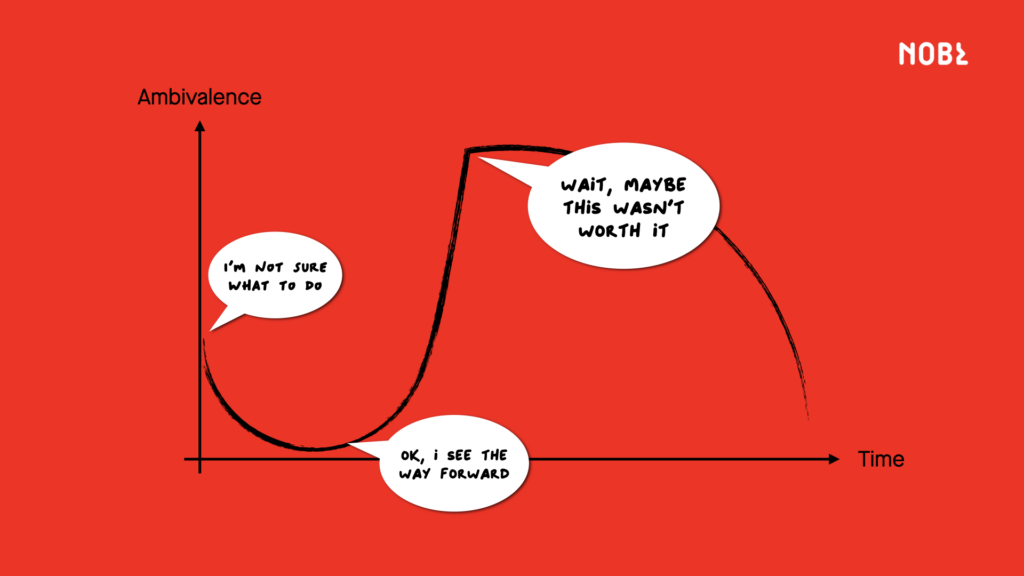Are you in the early stages of an organizational transformation, and as a leader, you’re struggling with overcoming self-doubt? Perhaps you’re:
- Feeling more anxiety and unease than normal when you’re asked to speak about the change? (e.g., “What if they ask that one question?”)
- Obsessing over small stumbles and early failures in the change, potentially inflating their importance or severity? (e.g., “How could we not see that coming?”)
- Ruminating over past choices you’ve made in the change (e.g., “Was that the right call?”)
- Questioning your own competence? (e.g., “Am I the right leader for this?”)
- Or even reflexively defending the change or shutting down discussion entirely? (e.g., “This isn’t the time to question things.”)
If you are in the early stages of a change, of course you’re feeling one or more of these. Of course! This moment in particular, when changes have been articulated and planned, when early attempts are underway (often both successful and unsuccessful), and when barriers are first revealing themselves, is under-discussed and often woefully simplified.
In retrospect, we are told stories of confident leaders who pointed their fingers to the sky and marched others, with total compliance, into some promised land. However, that story has never happened in the real world. Not once. Overcoming self-doubt and tolerating ambivalence are completely normal parts of every transformation.
Don’t sweat the stumbles. Assume they will happen, seek lessons from them, and then move your attention to building from wins.
In reality, the early stages of change trigger an enormous amount of ambivalence (i.e., conflicted feelings) not just across the organization, but also within leaders themselves. Yes, the very people who planned the change struggle with overcoming self-doubt and ambivalence (oftentimes, enormously). If you’re a leader, you know this firsthand.
Moreover, the ambivalence is loudest in the early stages of change. On one hand, you’re beginning to feel the benefits of the change, which bring optimism and a genuine sense of possibility (“I never knew we could really work differently”). On the other hand, for the first time you have a sober perspective of how much work is ahead, how dysfunctional your current reality really is, and just how big the barriers might be. And on top of both, you feel increasing pressure to champion the change and perform for others as their leader.
As a result, it’s no wonder why so many large-scale transformations fail at this stage. It’s not just that the organization bucks against the desired path, it’s that the leaders themselves struggle with the stress of it all and defect (walking away from either the change or the role itself). It makes one wonder how many transformations failed not because of the stated reasons (e.g. wrong idea, wrong time, wrong people) but because leaders suffered a crisis of confidence.

Tips for Overcoming Self-Doubt
If you truly believed in the need for change at the outset of a transformation, but now need help overcoming self-doubt:
- Seek a confidant. Look for someone that you can share your authentic feelings with without fear of their own response (e.g. worrying them about the situation or tarnishing their view of you professionally). Isolated leaders rarely sustain transformations or enjoy meaning in their work.
- Name the ambivalence you’re feeling and take the shame and blame out of it. Ambivalence is a normal part of any meaningful transition (it even shows up in personal changes). Investigate what’s driving your conflicted feelings without the meta-anxiety of feeling those feelings.
- With your newfound self knowledge, name the ambivalence that’s happening in others and the organization at-large. After you have spoken privately about it, you may find yourself more capably and confidently discussing it publicly.
- Re-ground yourself in why you set out on this change in the first place. Connect with what still feels true, and let in learning and even criticism if it shapes the change for the better.
- Don’t sweat the stumbles. Assume they will happen, seek lessons from them, and then move your attention and focus to building from wins. Moreover, don’t let every win morph into a loss simply because something wasn’t perfect.
- Build your other support structures: direct reports you can count on and delegate to, learning opportunities for yourself and others, coaching and mentorship, as well as simple peer connection.
Enduring despite the challenges is, unfortunately, key to overcoming self-doubt. Yes, the early stages of transformation are fraught with conflicting signals and feelings, but within that turmoil lies an opportunity for profound self-reflection and growth. As a leader, you can confront your own doubts and insecurities and forge deeper connections with your teams and cultivate a more authentic identity at work; both of which only help to ensure the transformation succeeds. Get more advice on preparing yourself to lead change in our executive guide.













